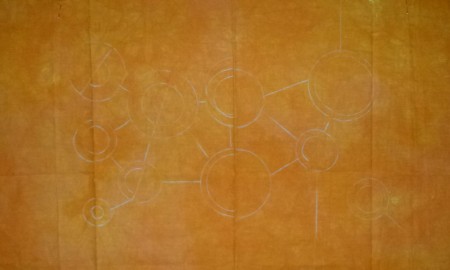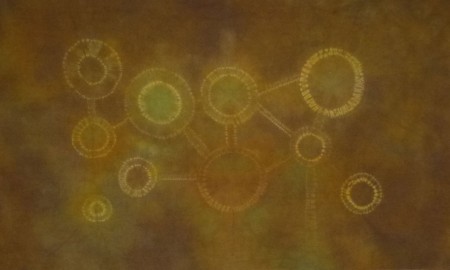If you joined my recent virtual tour of my studio, you may have noticed a scrunched up bundle of orange fabric sitting on my ironing board. It was a stitched resist shibori work in progress. Here are some before and after photos:


I started this piece for the Twelve by Twelve 2012 Map Challenge after viewing the utterly fantastic Living Water exhibition of contemporary aboriginal art at the Ian Potter Centre, National Gallery of Victoria (until 31 December 2012). I am always struck by the topographical quality of aboriginal art and how, way before white settlement of Australia, the indigenous people have identified and recorded key elements of their environment including water sources such as rock holes and soakage waters that are fed by underground springs.
Yet in the 19th century, Australian law applied the doctrine of “terra nullius” reinforcing the notion myth* that the land belonged to no one prior to the British Crown taking possession of it. Aboriginal people therefore could not sell or assign the land, nor could an individual person acquire it, other than through distribution by the Crown.
While the Queen celebrates the 60th anniversary of her coronation, this week marks the 20th anniversary of another significant event in Australian history. In 1992, in the Mabo case, the High Court of Australia rejected the application of terra nullius in favour of the common law doctrine of native title. The court upheld that the source of native title is the traditional connection to or occupation of the land, that the nature and content of native title is determined by the character of the connection or occupation under traditional laws or customs and that native title could be extinguished by the valid exercise of governmental powers provided a clear and plain intention to do so was manifest.
Significantly Mabo recognises, in certain cases, there was and is a continued beneficial legal interest in land held by local indigenous Australians which survived the acquisition of radical title to the land by the Crown. Furthermore, native title can co-exist with non-indigenous proprietary rights.
I’ll spare you the legal treatise but “in summing up…it’s Mabo, it’s justice, it’s law, it’s the vibe, and, uh … No, that’s it. It’s the vibe”. [The Castle, Working Dog Productions]
* Potentially, I could have carried this work over to the Twelve by Twelve Mythology challenge but, alas, in removing the resist threads, I somehow created holes in the fabric.

